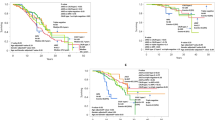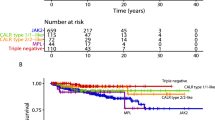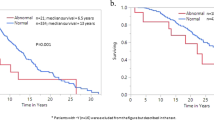Abstract
Unlike the case with thrombosis, prognostic models for survival and leukemic transformation (LT) in essential thrombocythemia (ET) are not available. Among 605 patients with ET seen at our institution and followed for a median of 84 months, 155 died and LT was documented in 20 patients (3.3%). In a multivariable analysis, hemoglobin level below normal (females<120 g/l; males<135 g/l) was identified as an independent risk factor for both inferior survival and LT. Additional risk factors for survival included age ⩾60 years, leukocyte count⩾15 × 109/l, smoking, diabetes mellitus and thrombosis. For LT, platelet count⩾1000 × 109/l but not cytoreductive therapy was flagged as an additional independent risk factor. In fact, four of the 20 patients (20%) with LT were untreated previously. We used the above information to construct prognostic models that effectively discriminated among low-, intermediate- and high-risk groups with respective median survivals of 278, 200 and 111 months (P<0.0001), and LT rates of 0.4, 4.8 and 6.5% (P=0.0009) respectively. Presence of JAK2V617F did not impact either survival or LT and mutational frequency was similar among the different risk groups.
This is a preview of subscription content, access via your institution
Access options
Subscribe to this journal
Receive 12 print issues and online access
$259.00 per year
only $21.58 per issue
Buy this article
- Purchase on Springer Link
- Instant access to full article PDF
Prices may be subject to local taxes which are calculated during checkout

Similar content being viewed by others
References
Rozman C, Giralt M, Feliu E, Rubio D, Cortes MT . Life expectancy of patients with chronic nonleukemic myeloproliferative disorders. Cancer 1991; 67: 2658–2663.
Mesa RA, Silverstein MN, Jacobsen SJ, Wollan PC, Tefferi A . Population-based incidence and survival figures in essential thrombocythemia and agnogenic myeloid metaplasia: an Olmsted County study, 1976–1995. Am J Hematol 1999; 61: 10–15.
Cervantes F, Tassies D, Salgado C, Rovira M, Pereira A, Rozman C . Acute transformation in nonleukemic chronic myeloproliferative disorders: actuarial probability and main characteristics in a series of 218 patients. Acta Haematol 1991; 85: 124–127.
Barbui T, Barosi G, Grossi A, Gugliotta L, Liberato LN, Marchetti M et al. Practice guidelines for the therapy of essential thrombocythemia. A statement from the Italian Society of Hematology, the Italian Society of Experimental Hematology and the Italian Group for Bone Marrow Transplantation. Haematologica 2004; 89: 215–232.
Harrison CN . Essential thrombocythaemia: challenges and evidence-based management. Br J Haematol 2005; 130: 153–165.
Elliott MA, Tefferi A . Thrombosis and haemorrhage in polycythaemia vera and essential thrombocythaemia. Br J Haematol 2005; 128: 275–290.
Cortelazzo S, Finazzi G, Ruggeri M, Vestri O, Galli M, Rodeghiero F et al. Hydroxyurea for patients with essential thrombocythemia and a high risk of thrombosis. N Engl J Med 1995; 332: 1132–1136.
Harrison CN, Campbell PJ, Buck G, Wheatley K, East CL, Bareford D et al. Hydroxyurea compared with anagrelide in high-risk essential thrombocythemia. N Engl J Med 2005; 353: 33–45.
Passamonti F, Rumi E, Pungolino E, Malabarba L, Bertazzoni P, Valentini M et al. Life expectancy and prognostic factors for survival in patients with polycythemia vera and essential thrombocythemia. Am J Med 2004; 117: 755–761.
Bernasconi P, Boni M, Cavigliano PM, Calatroni S, Brusamolino E, Passamonti F et al. Acute myeloid leukemia (AML) having evolved from essential thrombocythemia (ET): distinctive chromosome abnormalities in patients treated with pipobroman or hydroxyurea. Leukemia 2002; 16: 2078–2083.
Dan K, Yamada T, Kimura Y, Usui N, Okamoto S, Sugihara T et al. Clinical features of polycythemia vera and essential thrombocythemia in Japan: retrospective analysis of a nationwide survey by the Japanese elderly leukemia and lymphoma study group. Int J Hematol 2006; 83: 443–449.
Sterkers Y, Preudhomme C, Lai JL, Demory JL, Caulier MT, Wattel E et al. Acute myeloid leukemia and myelodysplastic syndromes following essential thrombocythemia treated with hydroxyurea: high proportion of cases with 17p deletion. Blood 1998; 91: 616–622.
Wolanskyj AP, Schwager SM, McClure RF, Larson DR, Tefferi A . Essential thrombocythemia beyond the first decade: life expectancy, long-term complication rates, and prognostic factors. Mayo Clin Proc 2006; 81: 159–166.
Chim CS, Kwong YL, Lie AK, Ma SK, Chan CC, Wong LG et al. Long-term outcome of 231 patients with essential thrombocythemia: prognostic factors for thrombosis, bleeding, myelofibrosis, and leukemia. Arch Intern Med 2005; 165: 2651–2658.
Bazzan M, Tamponi G, Schinco P, Vaccarino A, Foli C, Gallone G et al. Thrombosis-free survival and life expectancy in 187 consecutive patients with essential thrombocythemia. Ann Hematol 1999; 78: 539–543.
Kvasnicka HM, Thiele J . The impact of clinicopathological studies on staging and survival in essential thrombocythemia, chronic idiopathic myelofibrosis, and polycythemia rubra vera. Semin Thromb Hemost 2006; 32: 362–371.
Fenaux P, Simon M, Caulier MT, Lai JL, Goudemand J, Bauters F . Clinical course of essential thrombocythemia in 147 cases. Cancer 1990; 66: 549–556.
Finazzi G, Ruggeri M, Rodeghiero F, Barbui T . Second malignancies in patients with essential thrombocythaemia treated with busulphan and hydroxyurea: long-term follow-up of a randomized clinical trial. Br J Haematol 2000; 110: 577–583.
Kiladjian JJ, Rain JD, Bernard JF, Briere J, Chomienne C, Fenaux P . Long-term incidence of hematological evolution in three French prospective studies of hydroxyurea and pipobroman in polycythemia vera and essential thrombocythemia. Semin Thromb Hemost 2006; 32: 417–421.
Thiele J, Kvasnicka HM . A critical reappraisal of the WHO classification of the chronic myeloproliferative disorders. Leuk Lymphoma 2006; 47: 381–396.
Kokmen E, Ozsarfati Y, Beard CM, O'Brien PC, Rocca WA . Impact of referral bias on clinical and epidemiological studies of Alzheimer's disease. J Clin Epidemiol 1996; 49: 79–83.
Vardiman JW, Brunning RD, Harris NL . WHO histological classification of chronic myeloproliferative diseases. In: Jaffe ES, Harris NL, Stein H, Vardiman JW (eds). World Health Organization Classification of Tumors: Tumours of the Haematopoietic and Lymphoid Tissues. Lyon, France: International Agency for Research on Cancer (IARC) Press, 2001, pp. 17–44.
Thiele J, Kvasnicka HM . Hematopathologic findings in chronic idiopathic myelofibrosis. Semin Oncol 2005; 32: 380–394.
Bennett JM, Catovsky D, Daniel MT, Flandrin G, Galton DA, Gralnick HR et al. Proposals for the classification of the acute leukaemias. French-American-British (FAB) co-operative group. Br J Haematol 1976; 33: 451–458.
Steensma DP, Dewald GW, Lasho TL, Powell HL, McClure RF, Levine RL et al. The JAK2 V617F activating tyrosine kinase mutation is an infrequent event in both ‘atypical’ myeloproliferative disorders and myelodysplastic syndromes. Blood 2005; 106: 1207–1209.
Cabello AI, Collado R, Ruiz MA, Martinez J, Navarro I, Ferrer R et al. A retrospective analysis of myelodysplastic syndromes with thrombocytosis: reclassification of the cases by WHO proposals. Leuk Res 2005; 29: 365–370.
Merlat A, Lai JL, Sterkers Y, Demory JL, Bauters F, Preudhomme C et al. Therapy-related myelodysplastic syndrome and acute myeloid leukemia with 17p deletion. A report on 25 cases. Leukemia 1999; 13: 250–257.
Mauritzson N, Albin M, Rylander L, Billstrom R, Ahlgren T, Mikoczy Z et al. Pooled analysis of clinical and cytogenetic features in treatment-related and de novo adult acute myeloid leukemia and myelodysplastic syndromes based on a consecutive series of 761 patients analyzed 1976–1993 and on 5098 unselected cases reported in the literature 1974–2001. Leukemia 2002; 16: 2366–2378.
Hernandez JA, Florensa L, Sole F, Bosch MA, Espinet B . Acute myeloid leukemia with 17p abnormality in untreated essential thrombocythemia. Leukemia 2001; 15: 1308.
Tefferi A . Is hydroxyurea leukemogenic in essential thrombocythemia. Blood 1998; 92: 1459–1460.
Lengfelder E, Hochhaus A, Kronawitter U, Hoche D, Queisser W, Jahn-Eder M et al. Should a platelet limit of 600 × 10(9)/l be used as a diagnostic criterion in essential thrombocythaemia? An analysis of the natural course including early stages. Br J Haematol 1998; 100: 15–23.
Author information
Authors and Affiliations
Corresponding author
Additional information
Supplementary Information accompanies the paper on the Leukemia website (http://www.nature.com/leu)
Supplementary information
Rights and permissions
About this article
Cite this article
Gangat, N., Wolanskyj, A., McClure, R. et al. Risk stratification for survival and leukemic transformation in essential thrombocythemia: a single institutional study of 605 patients. Leukemia 21, 270–276 (2007). https://doi.org/10.1038/sj.leu.2404500
Received:
Revised:
Accepted:
Published:
Issue Date:
DOI: https://doi.org/10.1038/sj.leu.2404500
Keywords
This article is cited by
-
Blast phase myeloproliferative neoplasm: contemporary review and 2024 treatment algorithm
Blood Cancer Journal (2023)
-
Renin-angiotensin inhibitors reduce thrombotic complications in Essential Thrombocythemia and Polycythemia Vera patients with arterial hypertension
Annals of Hematology (2023)
-
Essential Thrombocythemia in Adolescents and Young Adults: Clinical Aspects, Treatment Options and Unmet Medical Needs
Current Treatment Options in Oncology (2023)
-
Low-risk polycythemia vera and essential thrombocythemia: management considerations and future directions
Annals of Hematology (2022)
-
Mortality outcomes and survival patterns of patients with myeloproliferative neoplasms in Malaysia
Cancer Causes & Control (2022)



